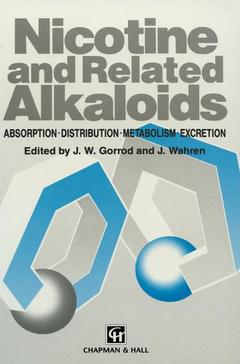Description
Nicotine and Related Alkaloids, Softcover reprint of the original 1st ed. 1993
Absorption, distribution, metabolism and excretion
Coordinators: Gorrod J.W., Wahren J.
Language: English
Subjects for Nicotine and Related Alkaloids:
Keywords
Oxidation; absorption; alkaloids; enzyme; enzymes; kinetics; metabolism; methylation; pharmacokinetics; research
Publication date: 10-2012
299 p. · 15.5x23.5 cm · Paperback
299 p. · 15.5x23.5 cm · Paperback
Description
/li>Contents
/li>
Nicotine is an alkaloid which is present, together with a number of minor alkaloids, in tobacco and a wide variety of other plants. The introduction of tobacco as a therapeutic agent against diverse pathologi cal and physiological conditions resulted in the widespread exposure of people to nicotine, and the subsequent recognition of the pleasurable effects of tobacco consumption. Tobacco may be used for pleasure by smoking it in pipes, cigars or cigarettes or by taking it in unsmoked form as oral and nasal tobacco snuff. Nonsmokers are exposed to nico tine through plant material and side-stream tobacco smoke. This means that in humans nicotine is always utilized in the presence of a very large variety of natural compounds or their pyrolysis products, depend ing on the route of administration. These compounds may modify the absorption, distribution, metabolism and excretion of nicotine and hence alter the duration of its pharmacological action. In recent years the use of nicotine in chewing gum and cutaneous patches has been developed as an aid to smoking cessation. The toxic properties of nicotine make it useful as an insecticide, which has led to its use in agriculture and horticulture. It has also recently been recog nized that tobacco consumption may be beneficial in the prevention of Parkinson's disease or in alleviating inflammatory bowel syndrome. The above observations have continued to stimulate research into the mode of action of this relatively simple molecule.
1 Biosynthesis and metabolism of nicotine and related alkaloids.- 1.1 Introduction.- 1.2 Alkaloid biosynthesis.- 1.3 Regulation of nicotine content in tobacco plants.- 1.4 Alkaloid transformations during senescence and curing.- Acknowledgement.- References.- 2 The mammalian metabolism of nicotine: an overview.- 2.1 Introduction.- 2.2 Primary carbon oxidation products of nicotine.- 2.3 The metabolism of cotinine.- 2.4 The metabolism of nornicotine.- 2.5 The metabolism of 4-(3-pyridyl)-4-oxobutyric acid.- 2.6 The N-oxidation of nicotine.- 2.7 Methylation reactions of nicotine and cotinine.- 2.8 Conjugation reactions.- 2.9 Conclusions.- Acknowledgement.- References.- 3 The roles of cytochrome P450 in nicotine metabolism.- 3.1 Introduction.- 3.2 Mechanisms of cotinine formation.- 3.3 Forms of cytochrome P450 participating in hepatic microsomal nicotine oxidation.- 3.4 Regulation of cytochrome P450 dependent nicotine metabolism.- Acknowledgements.- References.- 4 Nicotine metabolism beyond cotinine.- 4.1 Introduction.- 4.2 Oxidation of nicotine.- 4.3 Metabolism of cotinine.- 4.4 Conclusions.- References.- 5 N-Oxidation, N-methylation and N-conjugation reactions of nicotine.- 5.1 Introduction.- 5.2 N-Oxidation reactions of nicotine.- 5.3 N-Methylation reactions of nicotine.- 5.4 Glucuronidation reactions of nicotine.- 5.5 Nicotinamide nucleotide analogues of nicotine and cotinine.- References.- 6 Extrahepatic metabolism of nicotine and related compounds by cytochromes P450.- 6.1 Introduction.- 6.2 Pathways and enzymes of nicotine metabolism.- 6.3 Cytochrome—P450 isozyme specificity of nicotine metabolism.- 6.4 Extrahepatic metabolism of nicotine in relation to the localization of enzymes potentially participating in nicotine metabolism.- 6.5 Extrahepatic activation oftobacco-specific nitrosamines.- 6.6 Contribution of extrahepatic metabolism to the pharmacokinetics and toxicity of nicotine and related compounds.- 6.7 Unanswered important questions and suggestions for future work.- 6.8 Conclusions.- References.- 7 The metabolic fate of the minor tobacco alkaloids.- 7.1 Introduction.- 7.2 The metabolic fate of cotinine.- 7.3 ?-Nicotyrine.- 7.4 Other minor tobacco alkaloids.- Acknowledgement.- References.- 8 Nicotine and metabolites: analysis and levels in body fluids.- 8.1 Introduction.- 8.2 Nicotine and cotinine.- 8.3 3’-Hydroxycotinine.- 8.4 Glucuronic acid conjugates of nicotine, cotinine and trans-3’-hydroxycotinine.- 8.5 N-Oxides of nicotine and cotinine.- 8.6 N-Methylated derivatives of nicotine and cotinine.- 8.7 Nor- derivatives of nicotine and cotinine.- 8.8 Summary.- References.- 9 Kinetics of nicotine and its metabolites in animals.- 9.1 Introduction.- 9.2 Absorption kinetics and first-pass metabolism.- 9.3 Disposition kinetics.- References.- 10 Pharmacokinetics of (S)-nicotine and metabolites in humans.- 10.1 Introduction.- 10.2 Stable isotope methodology.- 10.3 Synthesis of labelled nicotine and metabolites.- 10.4 Analytical methodology.- 10.5 Pharmacokinetics of (S)-nicotine-3’,3’-d2.- 10.6 Pharmacokinetics of nicotine in smokers and nonsmokers.- 10.7 Bioavailability studies.- 10.8 Urinary excretion of nicotine metabolites.- 10.9 Pharmacokinetics of cotinine formation and elimination.- 10.10 Future studies.- 10.11 Conclusion.- Acknowledgements.- References.- 11 Sources of inter-individual variability in nicotine pharmacokinetics.- 11.1 Introduction.- 11.2 Absorption of nicotine.- 11.3 Distribution of nicotine.- 11.4 Metabolism of nicotine.- 11.5 Excretion of nicotine.- 11.6 Implications of inter-individualvariability in nicotine pharmacokinetics.- Acknowledgements.- References.- 12 Physiologically based pharmacokinetic modelling of nicotine.- 12.1 Physiologically based pharmacokinetic modelling.- 12.2 Potential utility of a PBPK model of nicotine.- 12.3 Development of the PBPK model of nicotine and cotinine in humans.- 12.4 Application of a multi-metabolite PBPK model of nicotine to exposure assessment.- 12.5 Low level nicotine exposure model.- 12.6 PBPK and nicotine pharmacodynamics.- 12.7 Summary.- Acknowledgements.- References.- 13 New methods for probing the disposition of nicotine in humans.- 13.1 Introduction.- 13.2 Regional catheterization.- 13.3 Positron emission tomography (PET).- 13.4 Nuclear magnetic resonance (NMR) techniques.- References.
© 2024 LAVOISIER S.A.S.




